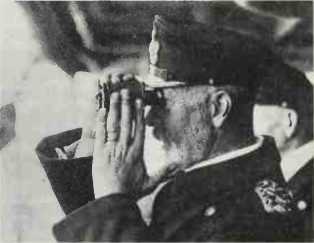Nic intelligence but the Americans also have specialized electronic “ferret” satellites in higher geosynchronous orbit for the latter work. An improved KH-12 with 4in (10cm) optical resolution and 20in (50cm) resolution imaging radar is due in 1989. Each satellite is intended to remain operational for 15 years. Soviet reconnaissance satellites tend to be smaller, currently 14,9601b (6,800kg), and shorter-lived. High-resolution satellites remain in orbit only for 6-8 weeks and use film capsules to get their information back to Earth, but area-surveillance satellites using digital readouts have been orbited since 1982 and remain operational for 180-200 days. EJG.
Saturation bombing see bombing.
Savoia-Marchetti SM 79 Spar-viero (Sparrowhawk) (Italian, WWII). Bomber/torpedo-bomber. Flight testing military prototype began September 2 1935; production deliveries from October 1936. Used in Spanish Civil War from February 1937; by June 10 1940, of 694 Sparuieri on strength, 403 were fully operational; widely and successfully used. Production, at least 1,330. Three 780hp Alfa-Romeo 126 RC34 engines; max. speed 267mph (430kph); 2,7561b (1,250kg) bombs, three 12.7mm and one 7.7mm machine guns.
Savoia-Marchetti SM 81 Pipistrelle (Bat) (Italian, WWII). Bom-ber/transport developed from SM 73 civil transport, 1935. Used in Abyssinian War, bombing, reconnaissance and air-supply missions; in Spanish Civil War operations of SM 81s started August 5 1936. June 1940 Regia Aeronautica had 304 serviceable; in use until 1944, serving Albania, Greece, Russia, Yugoslavia, Germany, Poland, Czechoslovakia, Austria and North Africa. Production, 584. Three radial engines: 670hp Piag-gio PX, 580hp Alfa-Romeo 125, 900hp Alfa-Romeo 126, 680hp Piaggio PIX or 650hp Gnome-Rhone K14. Max. speed (with PX) 211mph (340kph); 4,4101b
(2,000kg) bombs, five 7.7mm machine guns.
Savo Island, Battle of. Early on August 9 1942, the waters north of Guadalcanal became the scene of one of the US Navy’s worst defeats of World War II when American and Australian warships patrolling around Savo Island were surprised by a Japanese cruiser force under Vice Adm Mikawa. As a result of this action, which lasted less than an hour, the US cruisers Astoria, Quincy and Vincennes and the Australian cruiser Canberra were sunk.
Sayn-Wittgenstein, Maj Prince Heinrich zu (1916—44). Ger. The Luftwaffe’s third-ranking night-fighter pilot. After over 150 operations in bombers, he transferred to night fighters in 1941. Flying Ju 88s, he scored 83 victories, including 29 in Russia, before being shot down by an raf Mosquito in January 1944.
Scapa Flow. British naval base in the Orkneys. Occupied in both world wars by, respectively, the Grand and the Home Fleets. Remote but convenient for blocking the exits into the Atlantic from the North Sea and Norway.
Scarborough, bombardment of
(December 16 1914). Two German battlecruisers bombarded the British northeast coast harbour to little effect. No fleet action followed, but there was outrage in Britain, and the battlecruiser force was stationed at Rosyth as a precaution.
Scharnhorst and Gneisenau. (1) World War I, German armoured cruisers of cl2,000 tons. In von Spee’s East Asiatic Squadron, shared in victory at Coronel, November 1914; sunk at Battle of Falkland Islands, December 1914. (2) German battlecruisers, launched 1936; 32,000 tons standard; 9 X 11 in guns. Sank carrier hms Glorious, Norwegian campaign, 1940; sank 115,000 tons of shipping in North Atlantic, early 1941; broke out from Brest in “Channel Dash”, February 1942. Gneisenau permanently disabled by bombing at Kiel, 1942. Scharnhorst bombarded Spitzbergen, with Tirpitz, September 1943; sunk at Battle of North Cape, December 1943.
Scheer, Adm Reinhard K F
(1863-1928). Ger. A torpedo specialist, Scheer became cos. High Seas Fleet, in 1909; successively

Adm Scheer: bold manouevre at Jutland
Commanded its 2nd and 3rd Battle Squadrons, 1914-15; and in January 1916 succeeded the ailing von Pohl as its c-in-c. Like his predecessor, but more aggressively, he sought to lure out and destroy units of the Grand Fleet. A sortie intended to lead British warships into a U-boat ambush. May 31 1916, resulted in the Battle of Jutland (called Skaggerak by the Germans), when Scheer’s pursuit of British battlecruisers led him into action with the Grand Fleet. Scheer narrowly avoided Jellicoe’s “crossing the T” by a bold manouevre, signalling “battle turn away together” to his major units and sending his torpedo flotillas in to attack. He escaped a second trap by launching his battlecruisers on a near-sacrificial “death ride”. However, British mistakes and bad luck contributed substantially to Scheer’s successful extrication of his fleet. Following Jutland, his sorties were cautious and generally ineffectual. In August 1918, Scheer moved to the Admiralty, while Hipper became c-in-c: neither was able to deal effectively with the Kiel mutiny. CJWICD.
Schellenberg, Lt Gen (Obergrup-penfuhrer SS) Walter (1910
1952). Ger. A protege of Heydrich; became head of Germany’s combined military intelligence organizations in 1944 after the fall of Canaris. Self-serving and Machiavellian, he abetted Himmler’s peace negotiations, 1945.
Schlemm, Lt Gen Alfred (1894— 1986). Ger. Commander I Parachute Corps, Italian campaign, January-November 1944.
Schlesinger, James Rodney
(b. l929). US. Director, cia, January—July 1973; Secretary of Defense 1973-75.




 World History
World History









